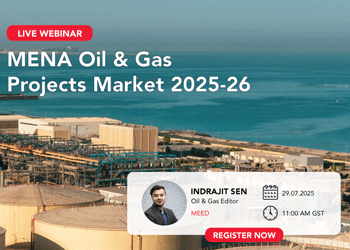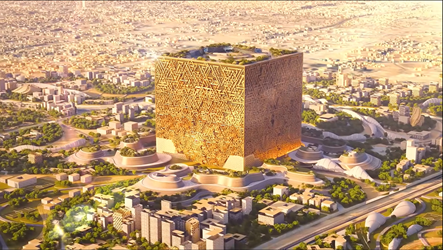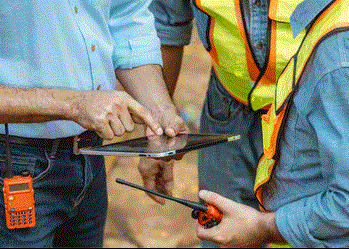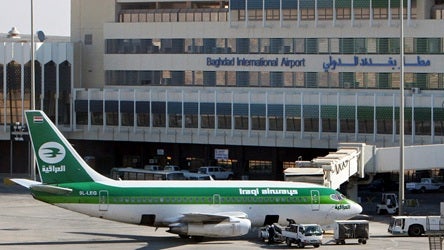Saudi Arabia transforms mining sector
23 February 2024

This month's Agenda also includes: Mergers soar in global mining sector
Saudi Arabia’s metals and mining industry is playing a pivotal role in the country’s non-oil growth trajectory.
Commercial exploitation of the kingdom’s massive mineral resource base, most of which lies untapped, is a key component of Riyadh’s Vision 2030 socioeconomic transformation strategy.
The kingdom took the first step towards realising the commercial potential of its mineral resources when it enacted a new mining investment law in 2021. Since the law came into effect, the Ministry of Industry & Mineral Resources (MIMR) has awarded more than 2,000 mining permits to local and foreign firms under its accelerated exploration initiative.
Addressing the Future Minerals Forum (FMF) in Riyadh in early January, Bandar Alkhorayef, the kingdom’s industry and mineral resources minister, said Saudi Arabia’s natural resources are worth $2.5tn – an increase of more than 90% compared with the 2016 estimated level of mineral reserves.
This near-doubling of its deposits of natural resources – which excludes fossil fuels and includes phosphate, gold and rare earths – is set to act as a stimulus to the kingdom’s nascent mining industry.
Mineral exploration drive
The MIMR is leading efforts to boost investments in the Saudi metals and mining sector, and Riyadh is providing impetus to the mineral exploration incentive programme with a cash injection of $182m.
“This programme will de-risk investments in our exploration, to enable new commodities, greenfield projects and junior miners,” Alkhorayef told the FMF.
To tap into overseas mining experience, the ministry signed four memorandums of understanding at the FMF.
Deals involving cooperation in the field of mineral wealth were signed with Egypt’s Petroleum & Mineral Resources Ministry, Morocco’s Energy Transition & Sustainable Development Ministry and Congo’s Mines of the Democratic Republic Ministry. A separate agreement inked with Russia involves geology.
Alkhorayef also announced the MIMR’s fifth and sixth mining concession licensing rounds at the conference in Riyadh. The rounds will offer local and international miners access to 33 exploration sites this year.
The ministry launched its last concession licensing round in August 2023, offering eight mining sites in the kingdom. Six of the sites are located in the Eastern Province – in Ghounan, Al Misnah, Al Samman, Ras Al Qaryah and the eastern and western zones of Salwa – and are understood to contain limestone ore, sand and other minerals.
The other two sites are in Riyadh Province, in Al Armah and Hofayrat Nesaah. These sites are estimated to hold gravel and sand deposits, among other minerals.
Prior to the August licensing round, the ministry announced in April that it had shortlisted 13 local and international companies for the exploration phase at the Muhaddad and Al Ridaniyah mining sites.
The Muhaddad exploration site, located in Bisha within the Asir geological terrane, covers 139 square kilometres and includes copper, zinc and lead ore deposits. The Al Ridaniyah exploration site is in the Riyadh region within the Al Dawadmi geological terrane. It covers more than 75 sq km and includes deposits of zinc and silver ore.
In January, the MIMR announced preferred bidders for another licensing round that it launched last April.
A consortium of local firm Ajlan & Bros Mining Company and Hong Kong-based Norin Mining Company is the preferred bidder for the Bir Umq exploration site. The site is located in the city of Mahd Ad Dhahab, in western Saudi Arabia. Covering about 187 sq km, the site contains deposits of copper and zinc.
As part of the licence awarded for this site, the winning consortium will invest over $29m in exploration activities. The consortium has also committed $4m for local community initiatives, including training and development programmes.
A consortium of UK-headquartered Royal Road and local entity MSB Holding Company has been picked as the preferred bidder for the Jabal Sahabiyah exploration site.
The site is located in the Tathleeth region, in the south of the kingdom, and covers an area of 283 sq km. Jabal Sahabiyah holds mineral deposits of zinc, lead and copper. The selected consortium will invest more than $5m in exploration work and another $120,000 in community development.
A consortium of Saudi Arabia-based Sumou Holding and Canada’s Kuya Silver has been selected for the Umm Hadid site and will invest more than $22m in exploration activities and about $800,000 in community development. Umm Hadid is located in the Afif region in central Saudi Arabia. Covering an area of 246 sq km, the site contains mineral deposits of silver, lead, copper and zinc.
The near-doubling of its deposits of natural resources is set to act as a stimulus to the nascent mining industry
Maaden steps up
Saudi Arabian Mining Company (Maaden) is at the forefront of Riyadh’s campaign to develop and expand the kingdom’s metals and mining sector. By 2040, the company, which is majority owned by the Public Investment Fund (PIF), aims to build its upstream mining capabilities, gain exposure to future minerals and form partnerships with global mining companies.
Last January, Maaden signed a joint-venture agreement with the PIF to establish a new company to invest in mining assets globally. Maaden owns a 51% stake and the PIF holds the other 49% in the company, known as Manara Minerals, which will have a capital allocation of $50m.
Manara Minerals aims to invest in iron ore, copper, nickel and lithium projects as a non-operating partner, taking minority equity positions. The firm’s first overseas investment was a deal in July to become a 10% shareholder in Brazilian mining major Vale’s $26bn subsidiary, Vale Base Metals.
In terms of metals production, Maaden announced in mid-January that its subsidiary Maaden Gold & Base Metals Company (MGBM) had started commercial production of gold from the first phase of the Mansourah-Massarah gold project.
MGBM operates six gold mines, with the Mansourah-Massarah mine being one of its concession areas. In June 2021, the Maaden subsidiary awarded an estimated $880m contract for the first phase of the Mansourah-Massarah gold mine to a consortium of India’s Larsen & Toubro and Finland-based Metso Outotec. The award of that engineering, procurement and construction (EPC) contract represents the biggest investment in gold mining in Saudi Arabia to date.
In August last year, MGBM also awarded an EPC contract for the second phase of the Mansourah-Massarah gold mine project, worth $28m, to a consortium of Riyadh-based Darkstone and Australia-headquartered ATC Williams. The contract involves installing tailings storage facilities and wastewater management systems.
Maaden exploration push
On the mineral exploration front, Maaden signed an agreement with US-based Ivanhoe Electric in July 2023 to undertake exploration for high-demand minerals in the Arabian Shield zone in Saudi Arabia. As part of the $130m deal, the partners are to survey an area of 48,500 sq km in the Arabian Shield, starting in September.
About the size of Switzerland, the Arabian Shield region is understood to be rich in reserves of minerals such as copper, nickel, gold, silver and possibly lithium.
Maaden has had success in its exploration drive. In late December, it announced the discovery of significant gold resource potential extending along a 100km strike from its Mansourah-Massarah gold mine. This is the first find from the company’s exploration programme, which was launched in 2022 with the aim of building Maaden’s production pipeline.
Exploration around Mansourah-Massarah has focused on identifying potential deposits of a similar scale and with similar geology. Encouraging drill results from several sites on Uruq South, along a 100km stretch south of Mansourah-Massarah, uncovered similar geological characteristics and chemistry to the gold deposit. These results include high-grade drill intercepts found 400 metres away from and under Mansourah-Massarah, with several high-grade intercepts.
In addition, Maaden has continued the expansion of its exploration footprint at the Jabal Ghadarah and Bir Tawilah prospects located 25km north of Mansourah-Massarah, where the company is converting an inferred resource of 1.5 million ounces to indicated and measured status.
In combination, these positive drilling results have identified a 125km strike with significant potential to become a major gold belt in Saudi Arabia. The near-mine drilling results around Mansourah-Massarah indicate that the resource is open both at depth and along the strike, offering significant potential to expand resources at the mine and possibly to extend the mine life with underground development.
Mansourah-Massarah had stated gold resources of almost 7 million ounces as of the end of 2023, and a nameplate production capacity of 250,000 ounces a year.
Positive drilling results have identified a 125km strike with the potential to become a major gold belt in Saudi Arabia
Maaden technology investments
To extend the role of technology in Saudi Arabia’s mining sector, Maaden signed a master agreement with Germany’s Thyssenkrupp Uhde at the FMF. The deal covers the development of engineering and licensing of a calcination plant for phosphogypsum processing.
The purpose of the proposed plant, which is to be located at Maaden’s Ras Al Khair site, is to recycle phosphogypsum and enable the capture of carbon dioxide (CO2) emissions. The joint research and development will be carried out together with Thyssenkrupp Polysius and Metso Outotec.
Also at the FMF, Maaden and US firm GlassPoint announced plans to develop a solar steam technology. The first stage of project development will have the capacity to supply 9 tonnes of steam an hour to begin the decarbonisation of Maaden’s aluminium supply chain, in what is expected to be the world’s largest industrial solar thermal project.
The technology will combine the direct generation of heat and storage to provide a continuous base load of steam to Maaden’s alumina refinery at Ras Al Khair. The initial capacity will be about 1% of the larger project, which is slated to save more than 12 million British thermal units of energy annually and reduce CO2 emissions by 600,000 tonnes a year.
Maaden and digital reality firm Hexagon also partnered at the FMF to launch a "digital mine".
“Hexagon’s life-of-mine technology solutions are being successfully deployed at the Mansourah-Massarah mine, combining sensor, software and autonomous technologies to enhance efficiency, productivity, quality and safety across the mine’s operations,” the companies said.
 Mergers soar in global mining sector
Mergers soar in global mining sector
MEED's October 2023 special report on Saudi Arabia includes:
 > COMMENT: Riyadh reshapes its global role
> COMMENT: Riyadh reshapes its global role
> POLITICS: Saudi Arabia looks both east and west
> SPORT: Saudi Arabia’s football vision goes global
> ECONOMY: Riyadh prioritises stability over headline growth
> BANKS: Saudi banks track more modest growth path
> UPSTREAM: Aramco focuses on upstream capacity building
> DOWNSTREAM: Saudi chemical and downstream projects in motion
> POWER: Riyadh rides power projects surge
> WATER: Saudi water projects momentum holds steady
> GIGAPROJECTS: Gigaproject activity enters full swing
> TRANSPORT: Infrastructure projects support Riyadh’s logistics ambitions
> JEDDAH TOWER: Jeddah developer restarts world’s tallest tower

Exclusive from Meed
-
 WEBINAR: Mena Oil & Gas Projects Market 2025-26
WEBINAR: Mena Oil & Gas Projects Market 2025-2610 July 2025
-

-
 Chinese firm wins Mid Island Parkway tunnelling deal
Chinese firm wins Mid Island Parkway tunnelling deal10 July 2025
-
 Iraq tenders Baghdad airport PPP project
Iraq tenders Baghdad airport PPP project9 July 2025
-

All of this is only 1% of what MEED.com has to offer
Subscribe now and unlock all the 153,671 articles on MEED.com
- All the latest news, data, and market intelligence across MENA at your fingerprints
- First-hand updates and inside information on projects, clients and competitors that matter to you
- 20 years' archive of information, data, and news for you to access at your convenience
- Strategize to succeed and minimise risks with timely analysis of current and future market trends

Related Articles
-
 WEBINAR: Mena Oil & Gas Projects Market 2025-26
WEBINAR: Mena Oil & Gas Projects Market 2025-2610 July 2025
Date & Time: Tuesday 29 July 2025 | 11:00 AM GST
Agenda:
1. Summary of the Mena oil, gas and petrochemicals projects market
2. Summary description of the main megaprojects, including project programmes
3. Analysis of active contracts and spending to date
4. Analysis of top contracts by work already awarded
5. Long-term capital expenditure outlays and forecasts
6. Highlights of key contracts to be tendered and awarded over the next 18 months
7. Top contractors and clients
8. Breakdown of spending by segment, ie, oil, gas, petrochemicals – upstream, downstream, onshore and offshore
9. Q&A session
https://image.digitalinsightresearch.in/uploads/NewsArticle/14241705/main.gif -
 New Murabba signs up South Korean firm for design works
New Murabba signs up South Korean firm for design works10 July 2025
Register for MEED’s 14-day trial access
Saudi Arabia’s New Murabba Development Company (NMDC) has signed a memorandum of understanding (MoU) with South Korea’s Heerim Architects & Planners to explore further design works on assets at the 14 square-kilometre New Murabba downtown project.
According to an official statement: “Heerim Architects & Planners will explore distinctive architectural plans that complement the development’s masterplan, with special focus on anchor assets, linear parks and smart city features.”
New Murabba CEO Michael Dyke signed the agreement last week during the company’s Investment and Partnership Forum in Seoul.
At the event, NMDC also signed an MoU with South Korea’s Naver Cloud Corporation to explore technological solutions for delivering the New Murabba downtown project.
According to an official statement: “The three-year agreement covers exploring innovative technology and automation to support the delivery of New Murabba, including robotics, autonomous vehicles, a smart city platform and digital solutions for monitoring construction progress.”
NMDC is in Seoul to examine technological offerings, assess financing options and showcase the investment opportunities available for the New Murabba downtown development.
The statement added that the excavation works for The Mukaab, the centrepiece of the overall development, have now been completed.
The Mukaab is a Najdi-inspired landmark that will be one of the largest buildings in the world. It will be 400 metres high, 400 metres wide and 400 metres long. Internally, it will have a tower on top of a spiral base and a structure featuring 2 million square metres (sq m) of floor space designated for hospitality. It will feature commercial spaces, cultural and tourist attractions, residential and hotel units, and recreational facilities.
Downtown destination
The New Murabba destination will have a total floor area of more than 25 million sq m and feature more than 104,000 residential units, 9,000 hotel rooms and over 980,000 sq m of retail space.
The scheme will include 1.4 million sq m of office space, 620,000 sq m of leisure facilities and 1.8 million sq m of space dedicated to community facilities.
The project will be developed around the concept of sustainability and will include green spaces and walking and cycling paths to promote active lifestyles and community activities.
The living, working and entertainment facilities will be developed within a 15-minute walking radius. The area will use an internal transport system and will be about a 20-minute drive from the airport.
The downtown area will feature a museum, a technology and design university, an immersive, multipurpose theatre, and more than 80 entertainment and cultural venues.
 READ THE JULY 2025 MEED BUSINESS REVIEW – click here to view PDF
READ THE JULY 2025 MEED BUSINESS REVIEW – click here to view PDFUAE and Turkiye expand business links; Renewed hope lies on the horizon for trouble-beset Levant region; Gulf real estate momentum continues even as concerns emerge
Distributed to senior decision-makers in the region and around the world, the July 2025 edition of MEED Business Review includes:
> AGENDA: UAE-Turkiye trade gains momentum> INTERVIEW 1: Building on UAE-Turkiye trade> INTERVIEW 2: Turkiye's Kalyon goes global> INTERVIEW 3: Strengthening UAE-Turkiye financial links> INTERVIEW 4: Turkish Airlines plans further growth> CURRENT AFFAIRS: Middle East tensions could reduce gas investments> GCC REAL ESTATE: Gulf real estate faces a more nuanced reality> PROJECTS MARKET: GCC projects market collapses> INTERVIEW 5: Hassan Allam eyes role in Saudi Arabia’s transformation> INTERVIEW 6: Aseer region seeks new investments for Saudi Arabia> LEADERSHIP: Nuclear power makes a global comeback> LEVANT MARKET FOCUS: Levant states wrestle regional pressures> GULF PROJECTS INDEX: Gulf projects index continues climb> CONTRACT AWARDS: Mena contract award activity remains subdued> ECONOMIC DATA: Data drives regional projects> OPINION: A farcical tragedy that no one can endTo see previous issues of MEED Business Review, please click herehttps://image.digitalinsightresearch.in/uploads/NewsArticle/14239016/main.jpg -
 Chinese firm wins Mid Island Parkway tunnelling deal
Chinese firm wins Mid Island Parkway tunnelling deal10 July 2025

Register for MEED’s 14-day trial access
Beijing-headquartered China Railway Tunnel Engineering Group has won a $60m subcontract for the tunnelling works on package 1B of the Mid Island Parkway project in Abu Dhabi.
Package 1B entails the construction of a cut-and-cover tunnel to cross the Khor Laffan Channel, which is the area between the Saadiyat and Um-Yifeenah islands.
The tunnel, which will be between 900 metres and 1 kilometre (km) long, is being constructed on a design-and-build basis and will tie in to packages 1A and 1C.
The project is being jointly constructed by a joint venture of local firm Yas Projects (Alpha Dhabi Holding) and Beijing-based China Railway International Group.
In June last year, MEED exclusively reported that Abu Dhabi's Department of Municipality & Transport had awarded contracts for three packages for phase one of the Mid Island Parkway Project (MIPP), as part of the Plan Capital urban evolution programme.
Phase one will start at the existing Saadiyat Interchange, which will connect the E12 road to the MIPP, and will end with the recently constructed Um-Yifeenah Highway.
It comprises a dual main road with a total length of 8km, including four traffic lanes in each direction, two interchanges, a tunnel and associated infrastructure works.
MIPP phase one is further divided into packages 1A, 1B and 1C, which were awarded separately.
The project ownership has been transferred from Aldar Properties to Abu Dhaibi's Department of Municipalities & Transport.
Previously, it was transferred from Abu Dhabi General Services Company (Musanada) to Aldar Properties, and the project was included in the Abu Dhabi Investment Office's public-private partnership project pipeline.
 READ THE JULY 2025 MEED BUSINESS REVIEW – click here to view PDF
READ THE JULY 2025 MEED BUSINESS REVIEW – click here to view PDFUAE and Turkiye expand business links; Renewed hope lies on the horizon for trouble-beset Levant region; Gulf real estate momentum continues even as concerns emerge
Distributed to senior decision-makers in the region and around the world, the July 2025 edition of MEED Business Review includes:
> AGENDA: UAE-Turkiye trade gains momentum> INTERVIEW 1: Building on UAE-Turkiye trade> INTERVIEW 2: Turkiye's Kalyon goes global> INTERVIEW 3: Strengthening UAE-Turkiye financial links> INTERVIEW 4: Turkish Airlines plans further growth> CURRENT AFFAIRS: Middle East tensions could reduce gas investments> GCC REAL ESTATE: Gulf real estate faces a more nuanced reality> PROJECTS MARKET: GCC projects market collapses> INTERVIEW 5: Hassan Allam eyes role in Saudi Arabia’s transformation> INTERVIEW 6: Aseer region seeks new investments for Saudi Arabia> LEADERSHIP: Nuclear power makes a global comeback> LEVANT MARKET FOCUS: Levant states wrestle regional pressures> GULF PROJECTS INDEX: Gulf projects index continues climb> CONTRACT AWARDS: Mena contract award activity remains subdued> ECONOMIC DATA: Data drives regional projects> OPINION: A farcical tragedy that no one can endTo see previous issues of MEED Business Review, please click herehttps://image.digitalinsightresearch.in/uploads/NewsArticle/14238039/main3047.gif -
 Iraq tenders Baghdad airport PPP project
Iraq tenders Baghdad airport PPP project9 July 2025
Register for MEED’s 14-day trial access
Iraq’s Ministry of Transport and the General Company for Airport & Air Navigation Services have released a tender inviting firms to bid for a contract to develop Baghdad International airport on a public-private partnership (PPP) basis.
The notice was issued in July, and the submission deadline is in September.
According to an official statement posted on its website, Iraq’s Ministry of Transport said that 10 out of 14 international consortiums that expressed interest in the project earlier this year have been prequalified to compete for the tender.
The scope of the estimated $400m-$600m project involves rehabilitating, expanding, financing, operating and maintaining the airport. It is the first airport PPP project to be launched in Iraq.
The initial capacity of the airport is expected to be around 9 million passengers, which will be gradually increased to 15 million passengers.
The International Finance Corporation (IFC), a member of the World Bank Group, is the project’s lead transaction adviser.
Iraq is already developing the Baghdad and Najaf-Karbala metro projects using a similar PPP model.
Earlier this month, MEED reported that Iraq intends to retender the contract to develop and operate the Baghdad Metro project, following the award of the estimated $2.5bn contract last year.
According to local media reports, Nasser Al-Assadi, adviser to Prime Minister Mohammed Sudani, stated that the previous developers had overestimated the project budget; therefore, the government will relaunch the entire process to implement the project.
https://image.digitalinsightresearch.in/uploads/NewsArticle/14229008/main.jpg -
 Contractors prepare revised bids for Roshn stadium
Contractors prepare revised bids for Roshn stadium9 July 2025

Register for MEED’s 14-day trial access
Saudi gigaproject developer Roshn has invited firms to submit revised commercial proposals by 24 July for a contract to build a new stadium adjacent to the National Guard facilities to the southwest of Riyadh.
Known as the National Guard Stadium, it will be delivered on an early contractor involvement (ECI) basis. It will cover an area of over 450,000 square metres and be able to accommodate 46,000 spectators.
The scope of work also covers the construction of auxiliary facilities, including training academy offices and two hotels, as well as retail and food and beverage outlets.
The firms had initially submitted bids on 8 April for the contract.
The stadium is scheduled to host 32 Fifa World Cup tournament games in 2034.
In August last year, MEED reported that Saudi Arabia plans to build 11 new stadiums as part of its bid to host the 2034 Fifa World Cup.
Eight stadiums will be located in Riyadh, four in Jeddah and one each in Al-Khobar, Abha and Neom.
The proposal outlines an additional 10 cities that will host training bases. These are Al-Baha, Jazan, Taif, Medina, Al-Ula, Umluj, Tabuk, Hail, Al-Ahsa and Buraidah.
The bid proposes 134 training sites across the kingdom, including 61 existing facilities and 73 new training venues.
The kingdom was officially selected to host the 2034 Fifa World Cup through an online convention of Fifa member associations at the Fifa congress on 11 December 2024.
 https://image.digitalinsightresearch.in/uploads/NewsArticle/14228507/main.jpg
https://image.digitalinsightresearch.in/uploads/NewsArticle/14228507/main.jpg


